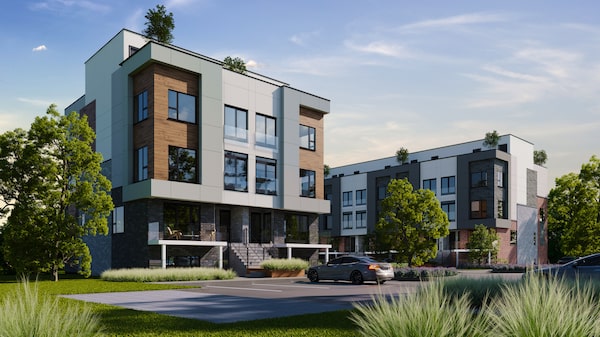
Handout rendering of a stacked-townhouse project by Sphere Developments in St. Catharine’s.Supplied
There was a time when land speculation was a game that almost anyone could play. But rising costs and tighter margins are changing the landscape for real estate development in Canada.
Some development companies that have launched in recent years are finding success buying land and bringing projects to market – so long as they are ready to jump in the deep end.
“I can tell you some of the deals we bought, the consultants thought we were crazy. We moved forward with it anyways,” said Alexander D’Orazio, of Brixen Developments. Brixen has bought or partnered on several sites since opening its doors in 2019 in Toronto, Oakville, Brampton, Barrie and Mississauga. For the most part though, the company was looking for “oven ready” deals with zoning or permissions already largely in place.
“We were buying land shovel ready … you’re buying the property close to its full potential, so obviously you pay a bit of a premium on it,” he said. “There’s very little margin for error, when buying zoned, ready-to-go sites.”
It’s not just new developers taking this approach. Even established companies such as National Homes have changed their mix of acquisition targets away from raw land plays.
“Currently we own a large land portfolio in Milton, which we bought 15 years ago, originally with intentions of building on a five- to seven-year horizon,” said Jason Pantalone, president and CEO of National Homes. He said that planning delays on raw land in the GTA have gotten much longer over the past 20 years. “Over the last three years, we’ve been focusing on more medium- to short-term. We’re not looking at long-term acquisitions due to things like carrying costs,” he said.
However, that approach also impacts how profitable each project is. “Typically, when you’re buying raw land without approvals in place, you’re buying with a discount,” meaning that much of the value is unlocked through the planning process, according to Mr. Pantalone. Buying land with approvals “provides more certainty to your business model, but it’s less profitable because you’re not creating that value-add.”
The Exhale Residences by Brixen Developments located on Lakeshore Rd. between Mississauga and Etobicoke.Brixen Developments
Since 2020 the real estate development market has dealt with several shocks created by the pandemic and its after-effects. Hard costs related to construction and materials have been difficult to predict with supply chain shortages, price changes and delays. Soft costs have also risen with soaring interest rates that change both the timelines of developers who have to borrow to build and the demand from buyers who need to borrow to buy.
At the same time, there’s wide recognition that most of Canada’s major urban areas are facing a housing crisis, and resale home prices continue to remain historically high, despite some softening in recent months.
The demand for affordable housing has created submarkets looking for denser, mid-rise or stacked townhouse development.
“We go forward in time to decide what is the exact price point we can swallow, to make sure that it’s affordable,” said Rohan Gawri, a partner with Sphere Developments, which started up in 2021. His company is planning to launch sales on two projects – in Mississauga and St. Catharines – in 2023, both sites that are engineered around a final sales price.
In St. Catharines, Sphere is planning a stacked-townhouse project on a former sports complex with an entry price around $500,000. The zoning would support a mid-rise, but for the final costs to work, Mr. Gawri is focusing on family-sized townhouses that won’t force the company to spend millions on underground parking structures, fancy lobbies or common element amenities. Another way they keep prices low is by avoiding bidding wars for land: “We do not buy any sites on the public market – we don’t even like looking at it. You’re competing with the rest of the world,” he said.
Brixen has targeted denser mid-rise projects in areas such as Barrie and Burlington, and is also keeping end-price in mind. But Mr. D’Orazio claims his competitive advantage comes from the efficiency of the company’s design and construction.
“We work very closely with engineers and architects, and we’ve definitely been able to find certain efficiencies that make a project more viable. Sometimes the seller doesn’t know what he has or is just leaning on his consultants,” who can be conservative, said Mr. D’Orazio. His team looks to squeeze more buildable square footage out of sites and make them cheaper to build with techniques honed in high-rise development with CentreCourt and Minto in Toronto.
“We acquired a site, and we closed on it in October of 2022 when things were getting worse, not better,” in terms of the market demand, he said. “We took a look at our costs and decided how we wanted certain pipe chases [the space between walls], brick versus window wall … we can sneak in a mezzanine level. … And that brought our price per [square foot] buildable from $120 to $100, which was extremely helpful.”
Those margin moves might not have been needed in the previous 15 years of GTA development, when rising revenues, prices and borrowing capacity could cover a lot of sins. As profits get tighter, Mr. Pantalone has seen an increase in what he calls mom and pop land speculators looking to sell partially zoned sites they have been trying to bring to market as relative amateurs on their own.
“I’m not going to call them developers; they are really more landowners,” he said. “And as revenues were increasing exponentially they were covering their shortfalls, they could recoup their mistakes with increasing revenues.
“This is now the real test of who can withhold and navigate more challenging times.”